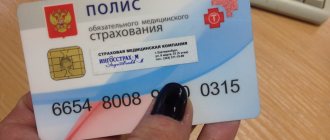Estimate
| Reviews: | 0 | Views: | 1447 |
| Votes: | 0 | Updated: | n/a |
File type Text document
Document type: Application
?
Ask a question Remember: Contract-Yurist.Ru - there are a bunch of sample documents here
APPLICATION FOR CHANGE OF LAST NAME, FIRST NAME, PATRONICAL NAME To the Civil Registry Office department of the Kirov district administration of Yaroslavl from Ilya Romanovich Chervyakov, residing at the address... APPLICATION I, Ilya Romanovich Chervyakov, ask to change my last name to “Romanovsky” due to the fact that I wish to bear the surname of my grandfather, who actually raised me. I provide the following information about myself: Time of birth: April 5, 1975 Place of birth: Yaroslavl Nationality: Russian Marital status: single Attitude to military service: not liable for military service Place of permanent residence: Yaroslavl, st. ... Place of work, position: RMZ, turner Information about children: I have not been Under trial or investigation I have not changed my last name, first name, patronymic before Full list of places in which I lived: Yaroslavl I am attaching the following documents to the petition: 1) autobiography; 2) birth certificate (of the applicant); 3) death certificate of the father - Chervyakova R.A.; 4) mother’s birth certificate (certifies relationship with grandfather); 5) a certificate from the house management about living together with the grandfather. I present passport series XXI-DA N 555555, issued on October 20, 1991 by the Department of Internal Affairs of the Kirov district of Yaroslavl. Warned of liability for giving false information. January 8, 1993 Signature
Download the document “Application for change of surname, name, patronymic”
The procedure for changing a child’s surname through the registry office
Each of us has the right to change our full name, but only according to established rules and by law. And this applies to any person, regardless of whether he is an adult or a child. It often happens that parents get divorced and for certain reasons one of them decides to change the child’s full name.
- The procedure is carried out upon submission of the appropriate application form to the guardianship and trusteeship authorities. The consent of both parents is required to change the child's name.
- After receiving official written notification that changing the child’s surname is permitted, it is necessary to submit the document to the registry office, where the necessary adjustments can be made.
- We receive a certificate of name change from the registry office. This stage is the final one for the minor and his parents.
The period for consideration of the application by the authorized body is 30 calendar days, but the period can be extended, if necessary, by an additional 60 days.
Other circumstances
The situations listed above are not exceptional. You cannot simply change the last name, like the rest of the child’s personal data. Only under certain circumstances can citizens contact the registration authority for help.
We suggest you read: How to prove rights to a garden plot for privatization
In addition to the situations listed above, it is possible to change a child’s last name before receiving a passport in the following cases:
- adoption;
- religious beliefs;
- the child’s desire to change his last name;
- remarriage of the child's mother/father;
- termination of parental rights of both legal representatives.
Another nuance that will have to be taken into account is the consent of the minor himself to the procedure. The Family Code of the Russian Federation states that changes in the passport details of a minor occur taking into account the opinion of the child himself, who has reached the age of 10 years.
The procedure for changing a child’s surname through the court
In certain cases, changing a child’s personal data is only possible in court:
- if you are refused by the OPP or the registry office, you can appeal both to the prosecutor’s office and to the judicial authority
- in case of a dispute between parents, in the absence of the consent of the second parent
- if a child refuses to change his last name or first name when he reaches 10 years of age
In what cases is the consent of the second parent not required:
- if it is impossible to establish the place of residence of the second parent
- the second parent has been deprived of parental rights
- parent declared legally incompetent
- if a parent evades the upbringing and maintenance of his child
If there is at least one reason above, or in case of challenging the actions of a government agency or for other reasons, the parent must take the following actions:
- Prepare a statement of claim to challenge the decision of a government agency on the above grounds
- Preparation of documents confirming your position on the dispute
- When considering a dispute in court, it is necessary to justify your position, the purpose of which is to change the last name, first name, patronymic, namely why it is necessary to change the data in the interests of the child
- After receiving the court decision, prepare an application to the OPP, then to the registry office, attaching the necessary documents
The process of filing a claim in court is accompanied by the payment of a state fee. So, when filing a claim in court, it is necessary to attach a receipt for payment of the state duty to it.
The court decision must enter into legal force within 30 days. After the expiration of the period, you can submit an application to the guardianship and trusteeship authority.
USEFUL: watch the video on the rules for drawing up a statement of claim in court, and also contact our lawyer for services in drafting
Where to submit?
You can submit your application in different ways. Typically, review occurs within a 30-day period. If there is a good reason, a person has the right to increase the period several times. During this time, he may change his mind, and for this he must notify the authorized body.
After this period, the person must contact the territorial civil registry office to obtain a certificate of change of surname.
It is this document that allows you to make changes to your passport and other certificates.
It is mandatory to change when changing:
- passport;
- international passport;
- driver license;
- medical insurance;
- SNILS.
At the registry office
Submitting an application to the registry office is no different from the standard procedure for registering a marriage.
A person comes at certain work hours and fills out form No. 15. Then he pays the state fee according to the specified details and attaches this document to the application.
A confirmation certificate is issued within 30 days.
At work
If a citizen is officially employed at work, then he is obliged to notify the employer, and in particular, the personnel department. There they will make amendments to the work book and other data that are necessary for the further transfer of social and other payments.
The HR department will need to write a corresponding application.
But there are no special requirements for the application. Its form is not described in any legislative act. Therefore, it is written either according to the employer’s format or in free form. It can be written either manually or printed on a printer.
An application is filled out in A4 format, where the full name of the employer or manager is written in the left corner, and then the name of the company. The position and full name of the applicant are also indicated there. A “statement” is written in the center. And only then, on the red line, the reason for the change of name and the request for changes are described.
Read how to make an entry in your work book about changing your last name. How to replace a medical insurance policy when changing your last name? Details here.
Is it necessary to change my license after changing my last name? Information in this article.
In custody
An application for guardianship is submitted only when the guardian or trustee changes his last name. This is also possible when changing the surname of an adopted person.
Within a 10-day period, the application is reviewed and a decision is made. Often filled out by a child 10–18 years old.
Who can change a child's last name?
Is it possible to change a child’s last name or first name? As we can see from the previous blocks, the main thing is to follow the described procedure. Let's figure out who will initiate these actions.
A change of surname can be initiated in the following cases:
- At the initiative of one of the parents. If the parents live separately from each other and the parent with whom the child lives wants to change the surname, he must:
- Obtain written consent from the other parent to change the surname
Submit an application to the guardianship and trusteeship authority (TPA) for permission to change the child’s surname
- Submit an application to change the child’s surname to the registry office
- Obtain a certificate of change of the child’s name, a new birth certificate
- By mutual will of both parents . In this case, with the consent of both parents and until the child has reached the age of 14 years, parents have the right to apply to the guardianship and trusteeship authorities to obtain permission to change the name or surname of one of the parents. After receiving consent, you must contact the registry office to obtain a certificate of name change
- On the initiative of the child himself . If a child has reached the age of 14, he can independently submit an application to the registry office to change his last name, and must obtain the written consent of his parents. In this case, there is no need to contact the guardianship authorities.
- On the initiative of the adoptive parents . The adoptive parent has the right to submit an application to the OPP, and then, if the answer is positive, to the registry office, an application to change the surname of the adopted child to his own. Also, the adoptive parent has the right to change the child’s name, as well as his patronymic, if this is necessary in the interests of the child
The patronymic name can be changed if paternity is established by another person in court. In other cases, until the child reaches the age of 18 or gains full legal capacity, it is impossible to change the child’s patronymic name.
Important : when a child reaches the age of 10 years, his opinion on changing his personal data is mandatory, the registry office is obliged to take it into account.
Is it necessary to change bank cards?
Changing personal data entails changing bank documents. It is necessary to change your Sberbank card when changing your surname due to marriage. It’s better not to delay this issue, no matter what kind of cards you have - credit, salary or pension.
If this is not done, difficulties will arise when using the cards:
- when performing a transaction through a cash register, a refusal may occur due to a discrepancy between the data in the bank database and the passport data;
- if the card is lost (or stolen), then it is difficult to gain access to your own money - you will have to confirm your identity;
- they will not be able to transfer the salary, since the person is listed in the accounting department with different data.
Therefore, you should change your salary card first.
Owners of unnamed card products will not have to change the card itself. But you must contact the bank so that the employees add new information to the agreement.
You can submit an application for re-issuance of the card and amendments to the agreement in your Sberbank personal account online.
What documents are needed to change a child’s last name, first name, patronymic?
Documents required to change a child's last name, first name or patronymic:
- Consent of the second parent
- Application to the guardianship and trusteeship authority
- Application to the registry office
- Receipt for payment of state duty
If the child has reached the age of 10 years, and if necessary, the following documents may be required:
- Independent application of a child over ten years of age
- Certificate of marriage between parents or divorce certificate
- Documents confirming the fact of paternity (decision of a judicial authority to recognize paternity of a person who has not married the child’s mother)
- Court decision on deprivation of parental rights
- Certificate of family composition. The certificate can be obtained from your management company, through the State Services portal or in person at the Municipal Services Center. The certificate has a unified form
Additionally, you may be asked to provide a certificate from the bailiff regarding the existence and amount of arrears for alimony obligations. In case of divorce and there is a writ of execution for the collection of alimony from one of the parents, the Applicant can provide, upon request of the state. authority, a certificate received from the bailiff in whose proceedings the collection of alimony is being carried out
How to submit an application
The form that must be submitted to the civil registry office is filled out as follows.
The header indicates the name of the registry office and the full name of the applicant. Next, a text is compiled indicating the old and new surname, date and place of birth.
It is also necessary to indicate citizenship and marital status, provide information about minor children, and passport information. The application must indicate the reason for the change of name.
It usually takes a month to process the application. This time is given to the applicant in case he suddenly changes his mind and abandons the idea of changing his last name.
You can also arrange everything through the State Services portal, however, to do this you first need to register and receive a password by mail.
If a change of surname occurs after marriage, you do not need to write additional applications, you just need to order a new identity card and receive it at the passport office. After the document is ready, you can apply for SNILS, TIN and international passport.
If the change of surname occurs at your own request, you must fill out the appropriate application on the portal, pay the fee by bank card and make adjustments to all documents.
What documents need to be changed after changing the last name?
After receiving a certificate of change of surname, the child must change the following documents:
- If you are over 14 years old, then the child’s passport
- Make changes to the parent’s passport (information about the child)
- Title documents for property (real estate, transport)
- In a marriage certificate, an employment contract (work book), in the information of the Unified State Register of Individual Entrepreneurs, the Unified State Register of Legal Entities, if the child is engaged in entrepreneurial activity - if the child is emancipated (received full legal capacity at the age of 16 to 18 years)
- In documents for the provision of services - preschool education organizations (kindergarten, clubs, courses), educational organizations (school, technical school, university)
- Deposits or other banking products opened in the child’s name in banks or other credit institutions
It is important to remember that if you change your last name, difficulties may arise when concluding other legal actions involving your child. For example, difficulties may arise when proving kinship in inheritance disputes. Moreover, such issues may also reach the court. A parent, guardian, or adoptive parent can be either on the side of the Plaintiff, in case of challenging the actions of a notary, or on the side of the Defendant, in case of challenging the transaction by other interested heirs.
USEFUL: watch the video and you will find out why Clients choose our organization as their assistant, write your question in the comments of the video and receive FREE legal advice on any issue
Reasons
After marriage, almost every girl takes her husband’s surname or a double one.
The decision is documented during registration.
Divorce also often causes changes in the passport.
Any citizen of the Russian Federation who has reached the age of majority has the right to change their last name.
The reason may be its cacophony or foreign roots.
about replacing the defendant
SAMPLE APPLICATION FOR REPLACEMENT OF THE DEFENDANT IN ____________________________________________ (name of the judicial district or court) _____________________________________________________ (address of the court or judicial district) Plaintiff: ____________________________________________ (F.I.O.
or name of the organization) _____________________________________________________ (postal address of the plaintiff, telephone, email.
address) Defendant: _____________________________________________________ (full name or name of organization) ____________________________________________ (address of the defendant, telephone, email address) APPLICATION TO THE COURT FOR REPLACEMENT OF THE DEFENDANT In the proceedings of ____________________________________________________________ (name of the court) there is a civil case No._____ on the claim of __________________________________ (F .AND ABOUT.
or the name of the plaintiff) to ___________________________________ o ___________________________________.
(Full name or name of the defendant) (subject of the dispute) According to Article 41 of the Code of Civil Procedure of the Russian Federation, the court, when preparing a case or during its trial in a court of first instance, may allow, at the request or with the consent of the plaintiff, the replacement of an improper defendant with an appropriate one. After replacing an improper defendant with a proper one, preparation and consideration of the case are carried out from the very beginning.
We recommend reading: How to separate the cost of food from the cost of train tickets
During the consideration of the civil case, it was established that at the time of the traffic accident, the civil liability of the culprit of the accident was insured not by the defendant, but by another insurance company. In this connection, claims were brought against the wrong defendant. Based on the above and guided by Articles 35, 41 of the Code of Civil Procedure of the Russian Federation, I ASK: 1. Consider this petition to replace the improper defendant 2. Replace the improper defendant with the proper _________________________________ (name of the proper defendant) APPENDIX: Copy of the petition according to the number of participants in the process Plaintiff: ________________________ _________ (last name and initials) (signature)
What needs to be changed along with the last name?
When changing a family name, a citizen will have to replace:
- passport (from the Federal Migration Service of the Russian Federation), including a foreign one;
- medical insurance;
- TIN;
- driver license;
- military ID;
- SNILS.
At the same time, the certificate and diploma remain unchanged.
In the labor document, the old data will be crossed out, and new data will be written on top.
It takes 30 days from the date of change of personal data to replace your passport. In addition, able-bodied and officially employed individuals must inform their superiors about the change of surname.
Here, a statement is also written (printed) on an A4 sheet, so that on its basis the employer makes amendments to the employment and other accounting papers:
The document is sent to the HR department. There are no special requirements for its design.
Students are required to notify the dean's office. Then the record must be re-registered. There will also be a change in the magazine.
Remember: no one can forbid you to change your family name. However, for this you need to have good reasons and submit an application to change your surname. Before taking this important step, it is better to consult with a registry office employee.
yuristotboga.com
Actions of the bailiff
If the debtor changes his last name, first name or patronymic, this will not entail the termination of enforcement proceedings. The bailiff reflects the new data of the debtor in the decisions he makes along with the old ones. Documents reflecting the changes that have occurred are attached to the materials of the enforcement proceedings.
Expert opinion
Lawyer Alexander Vasiliev comments
Changing the surname, first name, patronymic of an individual, changing the name of a legal entity without reorganization does not entail the removal of the person in a controversial legal relationship and procedural succession (Resolution of the Plenum of the Armed Forces of the Russian Federation dated May 28, 2020 No. 13 “On some issues of the application by courts of the norms of the Budget Code of the Russian Federation”). Therefore, there is no need to apply to the court to replace the party in the enforcement proceedings.
The bailiff issues a resolution to change the debtor's surname, and continues to enforce the court decision on the existing writ of execution.
Namesakes
In the practice of enforcement proceedings, there are cases when people are confused with their namesakes. Currently, identification in the FSSP database is carried out by full name and date of birth. If these data coincide for several people, they may be in for an unpleasant surprise in the form of enforcement proceedings or seizure of property in pursuance of a court decision to which the person has nothing to do.
Expert opinion
Lawyer Alexander Vasiliev comments
Since 2020, when filing applications with the court, it is necessary to indicate additional identifiers of the defendant - passport number, driver’s license or other data provided by law. They will allow you to accurately identify the debtor among many namesakes. But regarding previously opened enforcement proceedings, confusion is still possible. In addition, technical errors cannot be ruled out.
If your property or bank account is seized without reason, you must contact the bailiff conducting enforcement proceedings as soon as possible. Seizing property that does not belong to the debtor is illegal. Upon application by the owner of the wrongly seized property, he is obliged to cancel the seizure. If the bailiff hesitates to cancel, his inaction can be appealed. Read more about this here.











